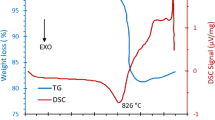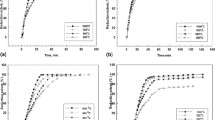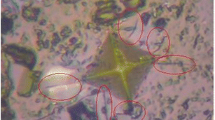Tungsten carbide (WC) is an important material mostly used for cutting-tool applications. The reduction of WO3 to WC is realized by using several techniques. The existing chemical processes involved in its reduction are long and energy consuming. In our work, we make efforts to reduce WO3 to WC by the reflux reaction technique. The composite obtained after the reflux reaction is analyzed to check the feasibility of conversion of WO3 to WC. The preliminary study demonstrates the feasibility of this conversion. The proposed technique seems to be promising and cost-effective for the low-temperature synthesis of ultrafine WC particles. The synthesized powders are studied with the help of X-ray diffraction, scanning electron microscope, energy dispersive X-rays, and transmission electron microscopy for the phase identification and microstructural analyses.




Similar content being viewed by others
References
I. Cha Seung, H. Hong Soon, H. Ha Gook, and Byung K. Kim, “Mechanical properties of WC–10Co cemented carbides sintered from nanocrystalline spray conversion processed powders,” Int. J. Refract. Met. Hard. Mater., 19, No. 4–6, 397–403 (2001).
J. M. Adeff Sanchez, A. Ordoneza, and R. Gonzalez, “HIP after sintering of ultrafine WC–Co hard metals,” Int. J. Refract. Met. Hard. Mater., 23, No. 3, 193–198 (2005).
M. Sherif El-Eskandarany, A. A. Mahday, H. A. Ahmed, and A. H. Amer, “Synthesis and characterizations of ball-milled nanocrystalline WC and nanocomposite WC–Co powders and subsequent consolidations,” J. Alloy Comp., 312, No. 1–2, 315–325 (2000).
K. Jia, T. E. Fischer, and B. Gallois, “Microstructure, hardness and toughness of nanostructured and conventional WC–Co composites,” Nanostruct. Mater., 10, No. 5, 875–891 (1998).
K. Jia and T. E. Fischer, “Abrasion resistance of nanostructured and conventional cemented carbides,” Wear, 200, 206–214 (1996).
C. S. Pande and K. P. Cooper, “Nanomechanics of Hall–Petch relationship in nanocrystalline materials,” Progr. Mater. Sci., 54, 689–706 (2009).
F. Zhang, J. Shen, and J. Sun, “Processing and properties of carbon nanotubes-nano-WC–Co composites,” Mat. Sci. Eng. A, 38, Nos. 1–2, 86–91 (2004).
L. E. McCandlish, B. H. Kear, and S. J. Bhatia, Spray Conversion Process for the Production of Nanophase Composite Powders, US Patent 535226 (1994).
L. Gao, B. H. Kear, and P. Seegopaul, Method of Forming Tungsten Particles, US Patent 5919428 (1999).
P. Seegopaul and L. Gao, Method of Forming Nanograin Tungsten Carbide and Recycling Tungsten Carbide, US patent 6524366 (2003).
B. K. Kim, G. G. Ha, and Y. Woo, Method of Production WC/Co Cemented Carbide Using Grain Growth Inhibitor, US Patent 6511551 (2003).
G. Lee, G. H. Ha, and B. K. Kim, “Synthesis of nanostructured W-base composite powders by chemical processes,” J. Korean. Inst. Metal. Mater., 37, No. 10, 1233–1237 (1999).
X. M. Ma, Z. Ling, J. Gang, and Y. D. Dong, “Preparation and structure of bulk nanostructured WC–Co alloy by high energy ball-milling,” J. Mater. Sci. Lett., 16, No. 12, 968–970 (1997).
R. Uribe, C. Baudin, L. Mazerolles, and D. Michel, “Sub-micron sized Al2TiO5 powders prepared by high-energy ball milling,” J. Mater. Sci., 36, No. 21, 5105–5113 (2001).
F. L. Zhang, C. Y. Wang, and M. Zhu, “Nanostructured WC/Co composite powder prepared by high energy ball milling,” Scripta. Mater., 49, No. 11, 1123–1128 (2003).
H. J. Fecht, “Synthesis and properties of nanocrystalline metals and alloys prepared by mechanical attrition,” Nanostruct. Mater., 1, No. 2, P.125–130 (1992).
H. J. Fecht, E. Hellstern, Z. Fu, and W. L. Johnson, “Nanocrystalline metals prepared by high-energy ball milling,” Metall. Mater. Trans. A, 21, No. 9, 2333–2337 (1990).
R. Porat, S. Berger, and A. Rosen, “Sintering behavior and mechanical properties of nanocrystalline WC/Co,” Mater. Sci. Forum, 225–227, No. 1, 629–634 (1996).
B. G. Butler, J. Lu, Z. G. Z. Fang, and R. K. Rajamani, “Production of nanometric tungsten carbide powders by planetary milling,” Int. J. Powder Metall., 43, No. 1, 35–43 (2007).
G. L. Tan and X. J. Wu, “Mechanochemical synthesis of nanocrystalline tungsten carbide powders,” Powder Metall., 41, No. 4, 300–302 (1998).
Z. G. Ban and L. L. Shaw, “Synthesis and processing of nanostructured WC–Co materials,” J. Mater. Sci., 37, No. 16, 3397–3403 (2002).
J. Hojo, T. Oku, and A. Kato, “Tungsten carbide powders produced by the vapor phase reaction of the WCl6–CH4 –H2 system,” J. Less-Common Metal., 59, No. 1, 85–95 (1978).
M. Fitzsimmons and V. K. Sarin, “Comparison of WCl6–CH4 –H2 and WF6–CH4 –H2 systems for growth of WC coatings,” Surf. Coat. Technol., 76, No. 1–3, 250–255 (1995).
J. C. Kim and B. K. Kim, “Synthesis of nanosized tungsten carbide powder by the chemical vapor condensation process,” Scripta. Mater., 50, No. 7, 969–972 (2004).
X. Tang, R. Haubner, B. Lux, and B. Kieffer, “Preparation of ultrafine CVD WC powders deposited from WCl6 gas mixtures,” J. Phys. IV Colloq., 510, 13–20 (1995).
C. W. Won, B. S. Chun, and H. Y. Sohn, “Preparation of ultrafine tungsten carbide powder by CVD method from WCl6–C2H2–H2 mixtures,” J. Mater. Res., 8, No. 10, 2702–2708 (1993).
G. Leclercq, M. Kamal, J. M. Giraudon, and P. Devassine, “Study of the preparation of bulk powder tungsten carbides by temperature programmed reaction with CH4 + H2 mixtures,” J Catal., 158, 142 (1996).
F. F. P. Medeiros, S. A. De Oliveira, C. P. De Souza, et al., “Synthesis of tungsten carbide through gas-solid reaction at low temperatures,” Mater. Sci. A, 315, No. 1–2, 58–62 (2001).
L. Gao and B. H. Kear, “Low temperature carburization of high surface area tungsten powders,” Nanostruct. Mater., 5, No. 5, 555–569 (1995).
H. Y. Sohn, T. Ryu, J. W. Choi, et al., “The chemical vapor synthesis of inorganic nanopowders,” Jom-Us, 59, No. 12, 44–49 (2007).
Y. Moriysohi, M. Futaki, S. Komatsu, and T. Ishigaki, “The preparation and characterization of ultrafine tungsten powder,” J. Mater. Sci. Lett., 16, No. 5, 347–349 (1997).
L. R. Tong and R. G. Reddy, “Synthesis of titanium carbide nanopowders by thermal plasma,” Scripta. Mater., 52, No. 12, 1253–1258 (2005).
A. Kumar, K. Singh, and O. P. Pandey, “Reduction of WO3 to nano-WC by thermochemical reaction route,” Physica. E, 41, 677–684 (2009).
C. S. Barrett and T. B. Massalski, Structure of Metals, Pergamon, Oxford (1980).
Author information
Authors and Affiliations
Corresponding author
Additional information
Published in Fizyko-Khimichna Mekhanika Materialiv, Vol. 49, No. 1, pp. 93–98, January–February, 2013.
Rights and permissions
About this article
Cite this article
Kumar, R., Kumar, A., Singh, S. et al. Reduction of WO3 to WC nanoparticles by the reflux reaction. Mater Sci 49, 102–109 (2013). https://doi.org/10.1007/s11003-013-9588-0
Received:
Published:
Issue Date:
DOI: https://doi.org/10.1007/s11003-013-9588-0




